Apple's 2010 MacBook Air (11 & 13 inch) Thoroughly Reviewed
by Anand Lal Shimpi on October 26, 2010 10:08 PM EST- Posted in
- Mac
- Apple
- MacBook Air
- Laptops
The 13
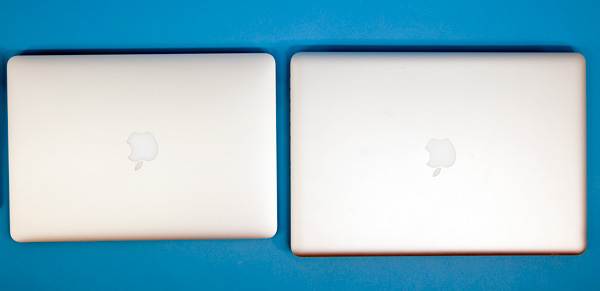
13-inch MacBook Air (left) vs. 15-inch MacBook Pro (right)
The 13-inch MacBook Air feels more like a regular notebook. It’s like one of those cartoons where you see the character straight on and he looks normal sized, but turn him 90 degrees and he’s pencil thin. When viewed from above you’d think you had a 13-inch MacBook Pro on your desktop. Its footprint isn’t that different:

But pick it up and you’re dealing with a much thinner notebook. Like the 11-inch MBA, the 13-inch model ranges from 0.11 inches to 0.68 inches in thickness. You get the same angular ID from the 11-inch model, just on a bigger scale.

13-inch MacBook Air (left) vs. 15-inch MacBook Pro (right)
The underlying hardware is unchanged, although you do get a noticeably quicker CPU. While the 11-inch model ships with a 1.4GHz Core 2 Duo (3MB L2 cache, 800MHz FSB), the 13-inch model comes with a 1.86GHz part by default (6MB L2 cache, 1066MHz FSB). I call it a noticeably quicker CPU because it is noticeably quicker, even in typical day to day use.
The 13.3-inch diagonal screen features a 1440 x 900 display (16:10 ratio). That’s the same screen resolution as the 15-inch MacBook Pro but in a smaller package. And it really makes a big difference when it comes to getting work done on the MacBook Air. This is a big improvement over the limited 1280 x 800 found in the previous two MacBook Airs and a high enough resolution to actually get work done on.
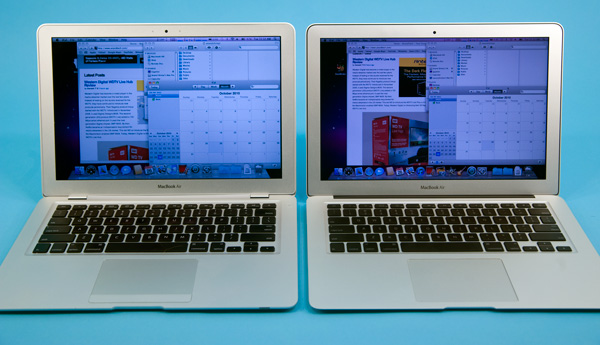
The old 13-inch MacBook Air (left) vs. the new 13-inch MacBook Air (right)
I’d go as far as to say that Apple could’ve bumped pixel density even further and the 13-inch MacBook Air would still be useable.
The 13-inch screen is a bit brighter and has a slightly better contrast ratio than the 11-inch, but it’s not something you’ll notice in use. The same vertical viewing angle limitations apply here. Unlike the 11-inch model however, you’re more likely to notice them because of the size of the display. On a plane when the passenger in front of you leans back all the way you’re probably going to have to angle the 13-inch display, while the 11-inch model may give you enough room to clear.
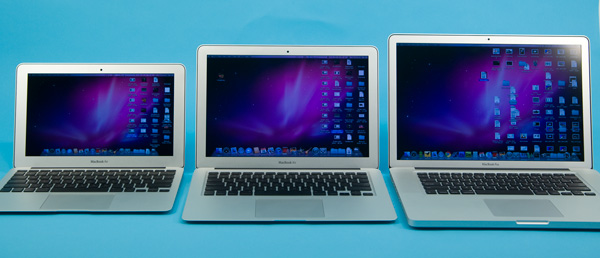
From left to right: 11-inch MBA, 13-inch MBA, 15-inch MBP
The trackpad on the 13-inch model is a taller rectangle, identical in size to what you’d find on a MacBook Pro. The wrist rest area is also normal-sized. In fact, other than the thickness there’s very little that separates the 13-inch MacBook Air from a 13-inch MacBook Pro.
Apple integrated an SD card reader with the 13-inch MBA which further identifies its light workhorse nature. It’s a nice addition that does make the MacBook Air more useful if you have a camera that uses SD cards (*grumbles at the D700*). The rest of the ports are unfortunately just as limited as the 11-inch model, but if you really want an Ethernet port you can either go the USB route or you can get a MacBook.
The stereo speakers are an improvement over the original MacBook Air. The old mono speaker was horrible to listen to. Now you've got two of them, which somehow makes the sound better. This isn’t exactly a set of Klipsch drivers but you get far less of a laughable sound out of them than before
The keyboard is identically sized to the 11-inch. You get larger function keys but there’s still no backlight. The backlit keyboard continues to be the biggest miss from the old MacBook Air.
Apple calls the new MacBook Air the future of the MacBook. If we take that literally it could mean that all future MacBooks will be the Air. Pro users will simply buy the bigger machines if they need the added performance, but the majority of users could get by with the Air. I tend to agree with this philosophy. There’s really no reason to get the base MacBook. The 13-inch MBA sacrifices a bit of performance and expansion, but you get a far more portable machine. For users who need the performance, there's always the Pro line.


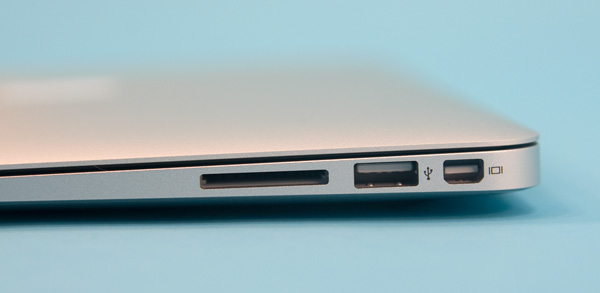
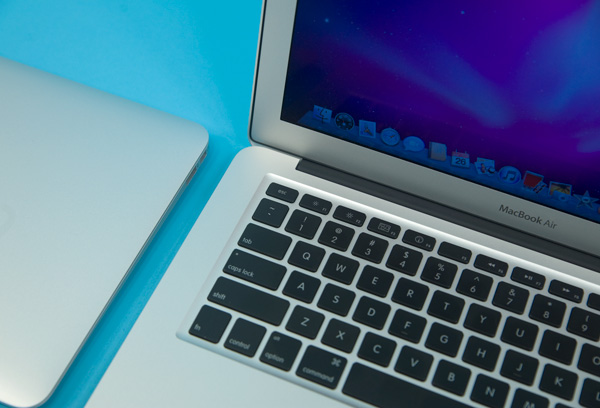








185 Comments
View All Comments
dsee15 - Wednesday, October 27, 2010 - link
Great thanks. Until then as a technical site, does anyone have a sense what the faster proc and additional 2GB mem do to performance? For example, it should run 20% faster for cpu intense apps, etc.Shadowmaster625 - Wednesday, October 27, 2010 - link
Well if you're spending money on any of these crapple concraptions then you are either not being productive or simply getting paid too much. Like those retired public employees who get paid 6 figure pensions for doing nothing. I dont know when that crap will stop, but I imagine it will be at around the same time apple flirts with bankruptcy.michael2k - Wednesday, October 27, 2010 - link
They have more cash than Microsoft. So after Microsoft flirts with bankruptcy?Shadowmaster625 - Wednesday, October 27, 2010 - link
They do have a lot of cash. But I can easily see them burning up half of it buying back their own stock once it starts tanking. And the other half could be burned up by just one or two flops. And that can easily happen once most apple lovers realize we are in fact in a depression and there is just no place for a company like apple in a depression.ShepherdH - Wednesday, October 27, 2010 - link
they just gave you more RAM and a larger hard drive at them. Same with most other Apple products.iwodo - Wednesday, October 27, 2010 - link
When Apple gets SandyBridge, i suspect 32nm, SandyBridge 1.8Ghz could do so within the same 1.4Ghz C2D Power envelop. But will be much more powerful. The only trouble is Apple wants CPU to be CPU, not a CPU with GPU built in.khimera2000 - Wednesday, October 27, 2010 - link
im not sure about that. they might just be looking for a sweet spot with CPU and GPU performance. in which case AMD's APU chips should be an intresting prospect since it gives you modern architecture on both sides in one chip.where intel took two dies and just slaped them together,AMD made it so the CPU and GPU can actualy talk to each other, also if AMD is to be beleaved this core would be retasked in the presance of another AMD card so the video chip on the CPU dosent become dead weight like the intel solution which just shuts down entirely in the presence of another card. (at least thats what i read)
personaly i think apple should get back into building there own hardware just like the g4 days. but that would require building there own OS, and seeing as mac hasent built an OS from the ground up for a long time (last time being os9? check out something called OpenStep) it might not be in there best intrest with win 7 getting so much traction and the failings of there previous Operating Systems it might not be good for the company to build something there not good at creating.
khimera2000 - Wednesday, October 27, 2010 - link
actually i dont think thats the case. there looking for a balanced system, and to this day intel has not released anything that can run a modern title (that i know of) if intel had a half way descent architecture on there vid cards i could see apple using it.however as things stand intel does not have a descent processer, and thats the reason why they have to use an nvidia video card. being that these notebooks use intergrated memory i can see that apple is looking for a specific perfomance point for there systems.
with that in mind i dont see why they wouldent consider AMD's soon to releas offerings. these chips has better gpu/cpu intergration then intel's options and sports the latest DX11 video architecture AMD has. I dont think theres anything in intel's arsinal that would be able to but heads with these chips from a graphic stand point, the only rogue facter in this is the new CPU architecture, since it has to yet be released.
Speaking of which... when can we expect to see reviews of the amd APU offerings from Anand? i would love to see how well it ticks, and a review to better define what makes it so differant from the intel chips that are comming out... perhaps an architetual comparison sometime in the future???
khimera2000 - Wednesday, October 27, 2010 - link
wow... i didnt know my first post went through for this response.. sorry about that. my connection hickuped. Love the sight keep up the good work :Dblufire - Wednesday, October 27, 2010 - link
You stated that the software restore drive is not write-protected, but Apple states that it is read-only. Who's right?http://support.apple.com/kb/HT4399
Thanks for the review!